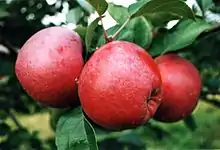Pacific Agri-Food Research Centre
The Pacific Agri-Food Research Centre (previously known as the Dominion Experimental Farm at Summerland and Summerland Research Station) is an agricultural research centre in British Columbia, Canada. The centre has been historically important in the development of tree fruits. It is administered by Agriculture and Agri-Food Canada and includes sites at Summerland and Agassiz.[1]
History

The centre was founded in 1914 as the Dominion Experimental Farm at Summerland. It was renamed as the Summerland Research Station in 1959 after the addition of plant pathology and entomology laboratories,[2] and later combined with a nearby experimental farm (at Agassiz, British Columbia) to form the Pacific Agri-Food Research Centre in 1996.[3] The centre was originally founded to research the suitability of different plant and animal species to local growing conditions, but later branched into plant pathology as well.[4] Early in its history, the centre also had an ornamental horticulture department, beginning with a garden laid out in 1916 that grew into a 6-hectare English landscape garden. As the centre's priority shifted to tree fruits, this program was phased out, and in 1991 care of the ornamental gardens was taken over by a local garden society.[5]
Notable research
The Pacific Agri-Food Research Centre has been particularly important in the development of tree fruit varieties; it is estimated that approximately 75–80% of cherries eaten worldwide are from varieties developed there.[6] The technology and processes to manufacture commercial fruit leather were also developed at the centre.[4]
Some notable fruit varieties developed at the Pacific Agri-Food Research Centre include:
 Coronation grapes
Coronation grapes Spartan apples
Spartan apples Stella cherries
Stella cherries
The centre also holds the Canadian Plant Virus Collection, which includes specimens of many plant viruses, some freeze-dried and others maintained alive in perennial plants.[2] The collection, one of the largest of its kind in the world, includes more than 350 isolated strains of 160 viruses, which are available for use as reference material in the event of viral outbreaks.[17]
Registered historical site
The former superintendent's residence at the centre is a listed site at the Canadian Register of Historic Places since 1990. Constructed between 1923 and 1926, the house is set within a private garden within the research station, and is the oldest surviving structure at the site. Initially built to house the station superintendent, it has not been used for that purpose since 1969, instead being used for an administration building, library, and museum.[18]
References
- "Science and Innovation: Pacific Agri-Food Research Centre"
- "Celebrating 100 Years of Research at Summerland Agriculture Centre" BC Gov News
- McIver, Susan "Pacific Agri-Food Research Centre celebrates 100 years" Penticton Herald
- Summerland Museum: Summerland, a Brief History
- "History of the Summerland Gardens"
- Symons, Gary "A Century of Innovation at Pacific Agri-Food Research Centre" Orchard and Vine Magazine
- C.R. Hampson; R.A. MacDonald; H.A. Quamme; D.-L. McKenzie & W.D. Lane (2005), "'8S6923' (Aurora Golden Gala™) Apple", HortScience, 40 (1): 251–253, doi:10.21273/HORTSCI.40.1.251
- "Fresh Market Grapes" British Columbia Grape Grower's Association
- "New Apple Cultivars: Creston". Retrieved 8 March 2014.
- Jubilee by Orange Pippin
- "Last Bite–From refugee to cherry breeder | Good Fruit Grower". goodfruit.com. Retrieved 2018-08-14.
- "SPA 440 (Nicola) Apple" HortScience 40(7):2204–2306. 2005.
- 'Skeena' Sweet Cherry HortScience 35(2):306–307. April 2000
- Stella, a Self-Fruitful Sweet Cherry Canadian Journal of Plant Science 51:252–253 (May 1971)
- Sweetheart wins award as Outstanding Fruit Cultivar Good Fruit Grower
- UC Davis Foundation Plant Services Prunus Encyclopedia
- "Crop Protection Biotechnology at the Pacific Agri-Food Research Centre in Summerland", Agriculture and Agri-Food Canada
- "Canada's Historic Places"
External links
- Summerland Research and Development Centre government homepage